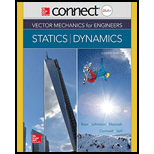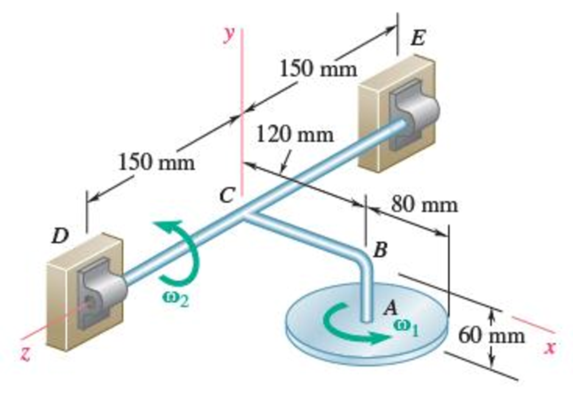
Concept explainers
A 2.5-kg homogeneous disk of radius 80 mm rotates with an angular velocity ω1 with respect to arm ABC, which is welded to a shaft DCE rotating as shown at the constant rate ω2 = 12 rad/s. Friction in the bearing at A causes ω1 to decrease at the rate of 15 rad/s2. Determine the dynamic reactions at D and E at a time when ω1 has decreased to 50 rad/s.

Fig. P18.103 and P18.104
The dynamic reactions at D and E at a time when
Answer to Problem 18.103P
The dynamic reactions at Dat a time when
The dynamic reactions at Eat a time when
Explanation of Solution
Given information:
The mass (m) of the disk is 2.5kg.
The radius (r) of the disk Ais 80 mm.
The angular velocity
The decreasing acceleration
Calculation:
The angular velocity
Write the equation of angular velocity of disk A
Write the equation of angular velocity
Find the equation of angular velocity
Substitute 0 for
Find the equation of angular momentum about A
Here,
Substitute 0 for
Find the rate of change of angular momentum
Here,
Write the equation of vector form of angular velocity
Write the equation of the rate of change of angular momentum about A
Substitute
Write the equation mass moment of inertia
Write the equation mass moment of inertia
Substitute
Find the position vector
Here, b is the horizontal distance and c is the vertical distance.
Write the equation of velocity
Substitute
Write the equation of acceleration of the mass center A of the disk.
Substitute
Sketch the free body diagram and kinetic diagram of the system as shown in Figure (1).

Refer Figure (1),
Apply Newton’s law of motion.
Substitute
Equate i-vector coefficients in Equation (4).
Equate j-vector coefficients in Equation (4).
Find the rate of change of angular momentum about E
Here,
Substitute
Apply matrix multiplication,
Take moment about E.
Here,
The moment at E is equal to the rate of change of angular momentum at E.
Equate Equation (7) and (8).
Convert the unit of radius from mm to m.
Convert the unit of b from mm to m.
Convert the unit of c from mm to m.
Convert the unit of l from mm to m.
Find the component of dynamic reaction
Equate
Substitute 2.5 kg for
Find the component of dynamic reaction
Equate
Substitute 2.5 kg for
Find the dynamic reaction at D using the equation:
Substitute
Thus, the dynamic reaction at D is
Find the component of dynamic reaction
Substitute Equation (11) in (5).
Substitute 2.5 kg for
Find the component of dynamic reaction
Substitute Equation (12) in (6).
Substitute 2.5 kg for
Find the dynamic reaction at E using the equation:
Substitute
Thus, the dynamic reaction at D is
Want to see more full solutions like this?
Chapter 18 Solutions
Connect 2 Semester Access Card for Vector Mechanics for Engineers: Statics and Dynamics
- The blade of an oscillating fan and the rotor of its motor shown have a total weight of 1 kg and a combined radius of gyration (for all axes) of 100 mm. They are supported by bearings at A and B, 125 mm apart, and rotate at the rate ω1 = 2000 rpm. Determine; a) the dynamic reactions at A and B when the motor casing has an angular velocity ω2 = (0.5 j+1.5 k) rad/s. b) the static reactions at A and B when the fan has stopped. Note: Assume that the center of mass of the entire system is between the middle of the bearings of A and B, that is 62.5 mm away from bearing A.arrow_forwardThe blade of a portable saw and the rotor of its motor have a total weight of 2.5 lb and a combined radius of gyration of 1.5 in. Knowing that the blade rotates as shown at the rate w1= 1500 rpm, determine the magnitude and direction of the couple M that a worker must exert on the handle of the saw to rotate it with a constant angular velocity w2= -(2.4 rad/s)j.arrow_forwardA thin, homogeneous triangular plate of weight 10 lb is welded to a light, vertical axle supported by bearings at A and B. Knowing that the plate rotates at the constant rate w = 8 rad/s, determine the dynamic reactions at A and B.arrow_forward
- A 1.6-kg tube AB can slide freely on rod DE which in turn can rotate freely in a horizontal plane. Initially the assembly is rotating with an angular velocity of magnitude w = 5 rad/s and the tube is held in position by a cord. The moment of inertia of the rod and bracket about the vertical axis of rotation is 0.30 kg.m2 and the centroidal moment of inertia of the tube about a vertical axis is 0.0025 kg.m2If the cord suddenly breaks, determine (a) the angular velocity of the assembly after the tube has moved to end E, (b) the energy lost during the plastic impact at E.arrow_forwardA 2.5-kg homogeneous disk of radius 80 mm rotates at the constant rate ω1 = 50 rad/s with respect to arm ABC, which is welded to a shaft DCE. Knowing that at the instant shown, shaft DCE has an angular velocity w2 = (12 rad/s)k and an angular acceleration a2= = (8 rad/s2)k, determine (a) the couple that must be applied to shaft DCE to produce that acceleration, (b) the corresponding dynamic reactions at D and E.arrow_forwardEach of the gears A and B has a mass of 675 g and a radius of gyration of 40 mm, while gear C has a mass of 3.6 kg and a radius of gyration of 100 mm. Assume that kinetic friction in the bearings of gears A, B C produces couples of constant magnitude 0.15 N.m, 0.15 N.m, 0.3 N.m, respectively. Knowing that the initial angular velocity of gear C is 2000 rpm, determine the time required for the system to come to rest.arrow_forward
- A 48-kg advertising panel of length 2a = 2.4 m and width 2b = 1.6 m is kept rotating at a constant rate w1 about its horizontal axis by a small electric motor attached at A to frame ACB. This frame itself is kept rotating at a constant rate w2 about a vertical axis by a second motor attached at C to the column CD. Knowing that the panel and the frame complete a full revolution in 6 s and 12 s, respectively, express, as a function of the angle 0, the dynamic reaction exerted on column CD by its support at D.arrow_forwardA slender homogeneous rod AB of mass m and length L is made to rotate at a constant rate w2 about the horizontal z axis, while frame CD is made to rotate at the constant rate w1 about the y axis. Express as a function of the angle 0 (a)the couple M1 required to maintain the rotation of the frame, (b) the couple M2 required to maintain the rotation of the rod, (C) the dynamic reactions at the supports C and D.arrow_forwardA 240-lb block is suspended from an inextensible cable which is wrapped around a drum of 1.25-ft radius rigidly attached to a flywheel. The drum and flywheel have a combined centroidal moment of intertia of 10.5 lb-ft-s^2. At the instant shown, the velocity of the block is 6 ft/s directed downward. The bearing at A as a frictional moment of 60 lb-ft. What is the kinetic energy of the system after the block moved after 4ft? (in ft-lb)arrow_forward
- The sheet-metal component shown is of uniform thickness and has a mass of 600 g. It is attached to a light axle supported by bearings at A and B located 150 mm apart. The component is at rest when it is subjected to a couple M0 as shown. If the resulting angular acceleration is a = (12 rad/s2)k, determine (a) the couple M0(b)the dynamic reactions A and B immediately after the couple has been applied.arrow_forwardThe 10-in.-radius brake drum is attached to a larger flywheel which is not shown. The total mass moment of inertia of the flywheel and drum is 22 lb ⋅ ft ⋅ s 2 and the coefficient of kinetic friction between the drum and the brake shoe is 0.41. Knowing that the initial angular velocity is 255 rpm clockwise, determine the force which must be exerted by the hydraulic cylinder at point B if the system is to stop in 85 revolutions. DO NOT ROUND OFF IN THE SOLUTION. ROUND OFF ONLY THE FINAL ANSWERarrow_forwardA small 2-kg sphere B is attached to the bar AB of negligible mass that is supported at A by a pin and bracket and connected at C to a moving support D by means of a spring of constant k = 3.6 kN/m. Knowing that support D undergoes a vertical displacement δ= δm sin wf t where δm = 3 mm and ωf = 15 rad/s, determine (a ) the magnitude of the maximum angular velocity of bar AB (b) the magnitude of the maximum acceleration of sphere B.arrow_forward
 Elements Of ElectromagneticsMechanical EngineeringISBN:9780190698614Author:Sadiku, Matthew N. O.Publisher:Oxford University Press
Elements Of ElectromagneticsMechanical EngineeringISBN:9780190698614Author:Sadiku, Matthew N. O.Publisher:Oxford University Press Mechanics of Materials (10th Edition)Mechanical EngineeringISBN:9780134319650Author:Russell C. HibbelerPublisher:PEARSON
Mechanics of Materials (10th Edition)Mechanical EngineeringISBN:9780134319650Author:Russell C. HibbelerPublisher:PEARSON Thermodynamics: An Engineering ApproachMechanical EngineeringISBN:9781259822674Author:Yunus A. Cengel Dr., Michael A. BolesPublisher:McGraw-Hill Education
Thermodynamics: An Engineering ApproachMechanical EngineeringISBN:9781259822674Author:Yunus A. Cengel Dr., Michael A. BolesPublisher:McGraw-Hill Education Control Systems EngineeringMechanical EngineeringISBN:9781118170519Author:Norman S. NisePublisher:WILEY
Control Systems EngineeringMechanical EngineeringISBN:9781118170519Author:Norman S. NisePublisher:WILEY Mechanics of Materials (MindTap Course List)Mechanical EngineeringISBN:9781337093347Author:Barry J. Goodno, James M. GerePublisher:Cengage Learning
Mechanics of Materials (MindTap Course List)Mechanical EngineeringISBN:9781337093347Author:Barry J. Goodno, James M. GerePublisher:Cengage Learning Engineering Mechanics: StaticsMechanical EngineeringISBN:9781118807330Author:James L. Meriam, L. G. Kraige, J. N. BoltonPublisher:WILEY
Engineering Mechanics: StaticsMechanical EngineeringISBN:9781118807330Author:James L. Meriam, L. G. Kraige, J. N. BoltonPublisher:WILEY





